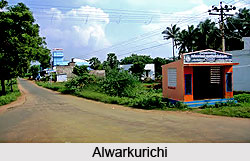 Alwarkurichi is a panchayat town nestled in the Tamil Nadu state of India. It is situated near the Western Ghats Mountain Range. The town is mostly enclosed by paddy fields. The Gadana River is located on the eastern side of the town and the Rama River is on the western side of the town. The town is home to myriad temples. These religious spots are frequented by various local as well as distant pilgrims.
Alwarkurichi is a panchayat town nestled in the Tamil Nadu state of India. It is situated near the Western Ghats Mountain Range. The town is mostly enclosed by paddy fields. The Gadana River is located on the eastern side of the town and the Rama River is on the western side of the town. The town is home to myriad temples. These religious spots are frequented by various local as well as distant pilgrims.
Location of Alwarkurichi
It is located in Tirunelveli district of Tamil Nadu. It is situated at a distance of 35 km from the Tirunelveli town and is 25 km away from Tenkasi town.
Demographics of Alwarkurichi
According to India census of 2001, Alwarkurichi had a population of 9447. The population of male was 50% and female was 50%. 11% of the population was under 6 years of age. On the basis of the report of same year, the town had an average literacy rate of 71% which was higher than the national average of 59.5%. The literacy rate of male was 56% and female was 44%. The official language of the town is Tamil.
Educational Institutions in Alwarkurichi
Alwarkurichi has established several schools and colleges to provide education to the students of the town. Sri Paramakalyani Higher Secondary School is a well known school imparting education to more than 2000 students. The school is well equipped with all the modern amenities such as Chemistry Lab, Physics Lab and Biology Lab. The other schools established in the town are STC Branch Primary School, Sri Sailapathi Middle School, Good Shepherd Matriculation School and Hindu Primary School. Sri Paramakalyani College is also established in the town. Sri Paramakalyani Centre for Environmental Sciences is a famous research centre in Alwarkurichi.
Pilgrimage Centers in Alwarkurichi
Alwarkurichi has an ancient Shiva temple known as Vanniappar Temple. Other important temples located here are Alamelu Manga Sametha Venkatachalapathy Temple, Sri Boomi Sametha Aadhinathar Temple, Aavudaiyambal Sametha Narasinganathar Temple and Sivakami Ambal Sametha Sivanthiappar Temple. A shrine dedicated to Alwars is also located here. The Rathotsavam festival is celebrated on a grand scale in the month of April. On the 8th day, Nataraja Abhishekam is organized on a grand scale by the family members of Late Sri Anantharamakrishnan.



















